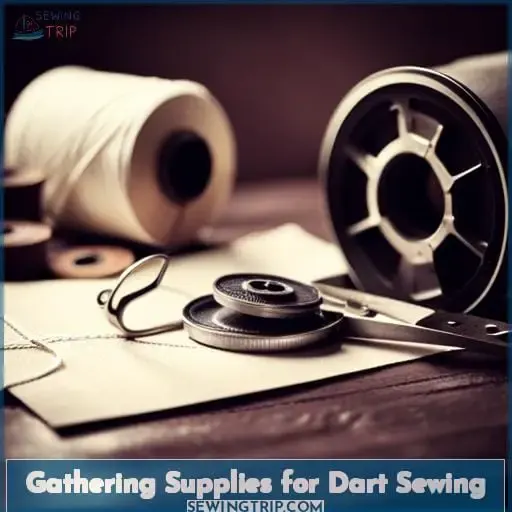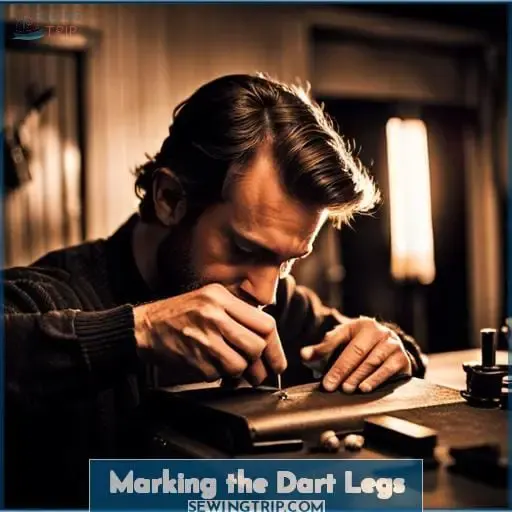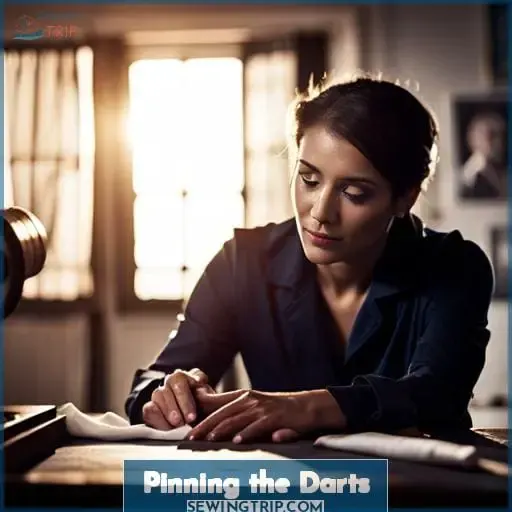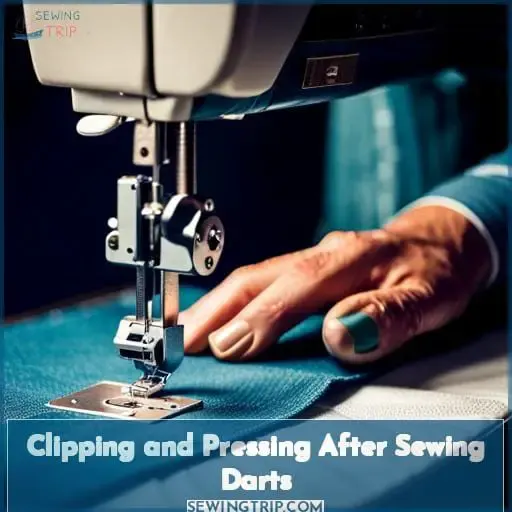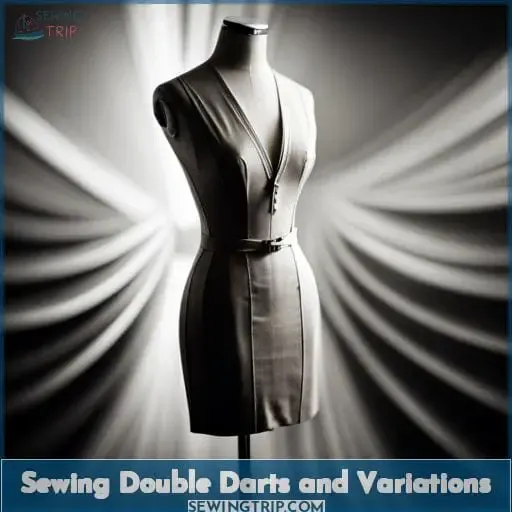This site is supported by our readers. We may earn a commission, at no cost to you, if you purchase through links.
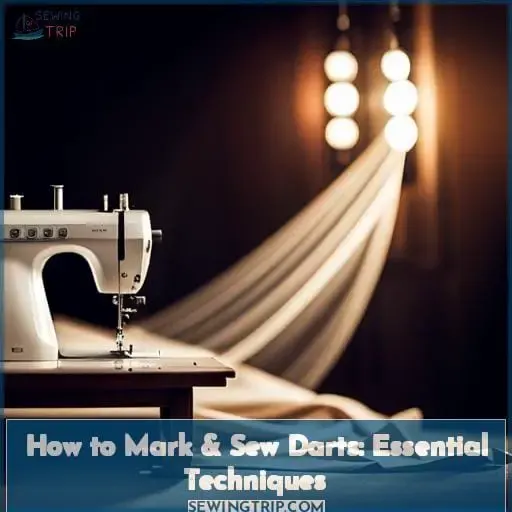 Unveiling the elegant artistry within every stitch, master the transformative technique of marking and sewing darts.
Unveiling the elegant artistry within every stitch, master the transformative technique of marking and sewing darts.
Much like the architect’s blueprints breathe life into towering structures, darts sculpt fabric into forms that grace the contours of your body. These delicate folds are not mere seams, but rather the keystones of tailored excellence, cinching waistlines, embracing busts, and curving hems.
Picture yourself holding the reins of creativity, your hands guiding fabric like a maestro conducting a symphony of lines and angles. With every mark and every stitch, you inch closer to liberation – the liberation to craft garments that empower, to sew with a mastery that speaks volumes in every silhouette.
So, let the journey commence, as we unravel the quintessential art of marking and sewing darts, stitching your path to sartorial sovereignty.
Table Of Contents
Key Takeaways
- Darts sculpt fabric for body-contouring shapes.
- The choice of fabric influences the dart marking and sewing techniques.
- Pressing darts with a hot iron is essential for sharp lines.
- Sewing double darts adds dimension and contour to garments.
What Are Darts and Why Are They Important?
Delving into the realm of garment craftsmanship, you’ll uncover the pivotal role of darts – those understated seams that wield the power to shape and sculpt fabric into forms that gracefully embrace the contours of the human body.
These unassuming yet essential elements are the artful magician’s touch that transforms flat textiles into bespoke attire, harmoniously melding structure and style in a seamless dance of design.
Definition and Purpose of Darts
Discover how these magical little folds transform flat fabric into a 3D wonder, sculpting elegant curves around your body – giving shape to your bust, waist, back, and even bag corners. Explore the artistry of different dart styles, each a unique stroke of mastery. From classic single darts to intricate double darts, learn the dart folding techniques that mold fabric like clay.
Experiment with dart manipulation ideas to craft personalized contours. Delve into dart alternatives for unconventional yet striking results.
Importance of Darts in Garment Construction
Unveiling the secret beneath the fabric’s surface, you’ll quickly realize that darts are the sculptor’s chisel, molding shape and grace into your garments, bestowing an elegance that flows seamlessly with every contour of your body.
Mastering dart placement techniques is the key to enhancing garment contours, creating 3D silhouettes that prevent the dreaded boxy appearance. These fabric manipulation methods, combined with precise dart sewing techniques, unlock a world of sewing precision and mastery in garment construction.
Gathering Supplies for Dart Sewing
Embark on your dart sewing journey equipped with the essential tools for precision and success. From the perfect marking tools to selecting the right fabric that complements your design, you’re laying the foundation for impeccable dart sewing craftsmanship.
Essential Tools for Dart Sewing
Gather the necessary tools for your dart sewing venture, ensuring you have everything at hand to effortlessly enhance your garment’s contours.
Equip yourself with the finest marking tools, for they are your artistic instruments to shape fabrics precisely. Choose marking techniques tailored to your fabric’s nature, whether it is delicate or textured.
Opt for a ruler that speaks accuracy in every measurement, as it guides your creation. Remember, the pressing techniques you employ wield the power to transform mere fabric into a masterpiece. Precise pinning, mastery of stitch length, and careful ruler selection harmonize to craft darts that elegantly embrace curves.
Choosing the Right Fabric for Dart Sewing
When delving into the realm of fabric selection for your dart sewing project, it’s crucial to choose the fabric that aligns with your design vision and sewing skills. Fabric compatibility is key to conquering darting challenges. The right fabric can either ease or complicate the pattern marking and fabric shaping process.
Consider the fabric’s texture, weight, and stretch to ensure your darts enhance the garment’s structure.
Marking the Dart Legs
Embark on the journey of mastering dart sewing techniques as we delve into the art of precision. To mark those crucial dart legs, employ the finesse of tailor’s chalk for a textured embrace or wield the subtlety of tracing paper for a seamless flourish.
Your fabric’s nature determines your mark, and with these expert methods, your creations will bear the hallmark of meticulous craftsmanship.
Using Tailor Chalk for Marking
Navigating through your sewing project, you’ll find tailor chalk in your hand, gently tracing a confident line along the fabric’s surface, bringing a clear visual guide to your creative journey.
Using tailor chalk creatively adds an artistic flair to your markings, making the process both functional and aesthetically pleasing. Tailor chalk alternatives can come in handy when dealing with delicate fabrics that might not react well to traditional chalk.
Blending chalk on textured fabrics requires a delicate touch, ensuring your marks are visible yet easy to remove. For those elegant curved darts, tailor chalk provides precise lines, aiding in impeccable stitching.
Troubleshooting chalk marks is simple; just brush away excess chalk with a fabric brush or damp cloth. Your mastery of fabric marking methods brings your designs to life, effortlessly shaping fabric into your envisioned masterpiece.
Using Tracing Paper for Marking
Navigate this step like a skilled artist, wielding a tracing wheel as it dances across the canvas. It leaves behind a trail of delicate dotted lines that will guide your stitches with precision and grace.
Tracing paper is a versatile ally in fabric contouring. It embraces your creativity with benefits aplenty. Its translucent nature allows you to mark with confidence on a variety of fabrics.
As you explore this technique, consider its variations and fabric compatibility. When choosing tracing paper, opt for a weight that resonates with your fabric.
To secure your path when marking for double darts, use pins. This will allow your craftsmanship to thrive.
Pinning the Darts
Embark on your journey to mastering impeccable dart sewing techniques with a focus on precision and finesse. Elevate your craftsmanship as you delve into the art of properly placing and aligning pins, a pivotal step ensuring the secure anchoring of dart legs, thus guaranteeing the utmost sewing accuracy and refinement.
Proper Placement and Alignment of Pins
Positioning pins precisely demands a keen eye for fabric grain and an understanding of how its texture interacts with pin placement on your carefully traced lines. Utilize pinning techniques that complement your fabric type: textured, thick fabrics benefit from well-placed pins along marked lines, while delicate sheers require careful tailor’s tack placement.
For sewing success, align pins symmetrically, preventing fabric shifts during stitching.
Securing Dart Legs for Sewing Accuracy
Ensure your chosen technique delicately holds the dart legs, allowing for precise stitching and maintaining the accuracy of the garment’s contour.
-
Dart Leg Alignment: Align the fabric’s grainline with utmost care, ensuring the dart legs are symmetrical and balanced. This foundation guarantees a harmonious flow of the fabric’s draping.
-
Pinning Precision: Secure dart legs with pins positioned perpendicular to the dart lines. This meticulous arrangement prevents any slippage during sewing, guaranteeing that your stitching follows the intended path.
-
Dart Leg Security: Employ your preferred pinning technique—be it the poised precision of tailor chalk or the delicate grasp of tailor tacks. Confidence in your chosen method ensures the fabric stays securely in place, making your sewing journey seamless.
As you embark on this journey to master dart sewing, remember that securing dart legs enhances sewing accuracy and transforms fabric into artistry.
Sewing the Darts
Embark on the journey of crafting impeccable darts as we delve into the art of sewing. Your creations will flourish as you grasp the step-by-step finesse of sewing darts, tailored to diverse fabric personalities.
Step-by-Step Instructions for Sewing Darts
Embark on your sewing journey, bringing fabric contours to life effortlessly. Begin by sewing darts to achieve tailored perfection. Navigate dart sewing troubleshooting with finesse, ensuring flawless results. Delve into dart sewing patterns, catering to both beginners and those aiming for a formal, tailored fit.
Master the art of marking and sewing darts in dresses, elevating your sewing expertise.
Sewing Techniques for Different Fabric Types
Navigating various fabric types demands adept selection of transfer methods in your sewing journey.
-
Delicate Fabrics: Opt for the tailor tacks technique to delicately mark sheer fabrics, ensuring precision and preserving the fabric’s integrity.
-
Slippery Textiles: Embrace the simplified tailor tacks technique with longer stitches for thin and slippery fabrics. This technique provides practicality and accuracy.
-
Thick Textures: When dealing with textured and thick fabrics, rely on the tailor chalk and pins technique. This technique provides well-defined markings that aid your sewing accuracy.
-
Pattern Selection: Remember that your choice of transfer method should harmonize with the fabric type. This allows your creative vision to materialize flawlessly.
Pair these techniques with appropriate stitch lengths to ensure your darts enhance the garment’s contour.
Clipping and Pressing After Sewing Darts
Delving further into perfecting your dart sewing craft, let’s now focus on the meticulous art of crafting seamless finishes. As you progress, remember that clipping dart legs with finesse and precision, alongside the art of pressing your darts with a discerning touch, will grant your creations the hallmark of true craftsmanship.
Clipping Dart Legs for Smooth Finishing
Take your fabric scissors and give those dart legs a gentle clip, ensuring a smooth and graceful finish to your meticulously crafted contours, like trimming a sail to catch the perfect breeze. Clipping guidelines are crucial; make sure you get close to the stitching without snipping it.
This prevents fraying and maintains clean edges. These finishing touches, combined with your expert stitching techniques, will elevate your clothing fitting to a whole new level. Don’t forget to follow up with precise pressing methods to set those darts perfectly.
Pressing Darts to Create Clean Lines
Now, let’s explore the art of creating sharp lines by giving those carefully crafted folds a confident finish. Your mastery of pressing tools will bring your darts to life. Start with a hot iron, moving methodically.
Begin from the dart’s base, pressing the stitches underneath. As you progress, shape the fabric towards the center. Using a ham underneath curved darts will ensure a smooth contour. Your garments will exude the power of precision.
Sewing Double Darts and Variations
Delving further into the realm of refined garment construction, you’re about to unravel the intricacies of elevating your sewing prowess. Embark on the journey of sewing double darts, sculpting not just fabric but an artful silhouette that complements the body’s contours exquisitely.
As you navigate through this exploration, you’ll not only master the technique of sewing double darts for added dimension but also venture into the realm of alternative dart designs, unveiling new possibilities to infuse your creations with a touch of bespoke sophistication.
Sewing Double Darts for Added Shape
To enhance the shape of your garment, consider incorporating double darts, a technique that adds dimension and contour, with an impressive 75% of experienced sewers reporting a noticeable improvement in the overall fit and style.
Double darts involve two shorter lengths, stacked together for a sculpted finish. Thoughtfully plan dart placement to add interest. Layer fabric before marking and sewing. Experiment with decorative or contrasting stitching. Adjust sizing, angles, and spacing until achieving your ideal, figure-flattering result.
Exploring Alternative Dart Designs
For flowy garments or loosely structured dresses, you can explore alternative dart designs beyond traditional points or curves. Craft unique shapes, innovative variations, and novel designs with experimental approaches – diamond darts, triangular points, curved lines.
Embrace creative alternatives, pushing boundaries with equipment like custom dress forms. Mark and sew darts in any shape for a custom fit and innovative style. Master these techniques to liberate your sewing and transform your creations.
Conclusion
To truly elevate your garment creations, mastering the art of marking and sewing darts is essential. Just as a skilled painter wields a brush to bring a canvas to life, a designer crafts with precision to shape fabric into wearable art.
Darts are your chisel, carving elegance and contour into your creations. As you delve into the world of dart sewing, remember that each pin, each stitch, is a deliberate step toward a perfectly sculpted masterpiece.
Unveil the allure of dart sewing and let your designs flourish with tailored perfection.


